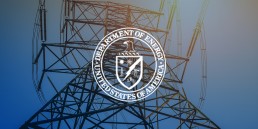Supply Chain Innovation a Critical Component of DOE Roadmap to Enhance Grid Resilience
By Suedeen G. Kelly, former Commissioner, Federal Energy Regulatory Commission
Earlier this month, the Department of Energy released a “roadmap” for its Energy Storage Grand Challenge, outlining DOE’s strategy to accelerate innovation and commercialization of promising energy storage technology. DOE is also seeking stakeholder input on a lengthy set of questions related to the activities proposed in the Roadmap.

The Roadmap is the latest activity aimed at fulfilling the mandate of the 2018 DOE Research and Innovation Act, itself designed to assert U.S. leadership in research, innovation and development of advanced energy storage technology, as well as the use of that technology worldwide. The Act also encourages DOE to use “crosscutting approaches” and “prioritize activities that use all affordable domestic resources.”
At a time when the energy landscape is undergoing global transformation, and energy storage will undoubtedly play an ever-increasing role in managing and meeting electricity demand, it makes good sense for DOE to be pursuing a U.S. leadership position in emerging technologies that can help strengthen and protect the very lifeblood of our nation, our electric generation and delivery system (the grid).
While electric utilities and their research branches are the ones that generally drive grid innovation, having the government sponsor basic research can produce major benefits, including the synergistic effect that is produced when government-funded foundational research, which is generally too costly for the private sector to undertake, is then handed over the private sector for later-stage innovation and commercialization.
A prime example of federal research funding working synergistically with private sector innovation is in information technology (IT) industry, where government-funded academic research provided the foundation for such companies and technologies as the Internet, Google’s search engine, global positioning systems, supercomputers, smartphones and artificial intelligence.[i]
This approach should result in faster technology development and commercialization and, by doing so, also position the U.S. as a prime manufacturing source for such technologies.
The Roadmap has five tracks for DOE activity, including one that is particularly important to utilities and the grid, the Manufacturing and Supply Chain Track, which could help the industry tackle major concerns about global supply chain integrity and grid vulnerability to cyberattacks.
The Manufacturing and Supply Chain Track will focus on identifying and addressing barriers to lowering domestic manufacturing costs and improving the performance of storage systems, both of which could contribute to greater grid resilience. The DOE Roadmap identifies five goals, including:
1. Improving understanding of technical barriers in production and manufacturing energy storage technologies;
2. Prioritizing materials and manufacturing processes that can overcome those barriers;
3. Accelerating commercial scale-up of emerging manufacturing processes;
4. Improving the critical materials supply chain; and,
5. Establishing a domestic battery manufacturing ecosystem.
In combination, achieving these five goals could help secure the supply chain, support continued growth of renewables in our energy mix, and address concerns about the availability of critical battery materials such as lithium, approximately 83 percent of which currently derives from four countries — Chile, Australia, Argentina, and China, in that order. The U.S. ranks fifth, with the balance coming from Zimbabwe, Brazil, and Portugal. Moreover, in 2018 the top producers of lithium battery cells were all foreign companies.
The DOE Roadmap also has four other tracks: technology development (a portfolio of energy storage technologies that have an R&D pathway to achieve significant progress); technology transition (accelerate technology pipeline research to private-sector adoption by providing validation and financing); policy and valuation (support policy development while maximizing the value of energy storage); and, workforce development (for research, design, manufacture, and operations).
DOE’s program is, indeed, a grand challenge, but one that is necessary at a time when the global energy landscape is rapidly changing, cyberattacks on the U.S. electric grid are escalating every day, and advances in technology hold great promise for a cleaner more sustainable energy future. Let us hope that this grand challenge achieves the same level of innovation and commercial success as past government-funded research — future generations will surely thank us.
[i] See Federally Supported Innovations: 22 Examples of Major Technology Advances that Stem from Federal Research Support, Peter L. Singer, Information Technology and Innovation Foundation, 2014.
Suedeen Kelly
Author Bio